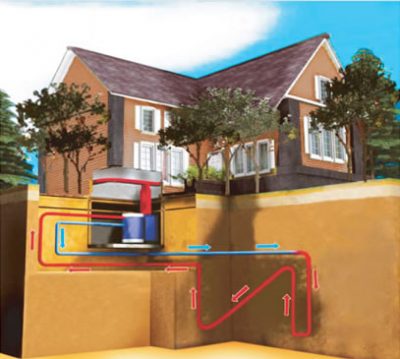August 21, 2018 – First-time guest blogger, Arthur Smith, today is writing about an energy source most developers of new subdivisions and buildings overlook. Smith describes himself as the main editor of LEDwatcher.com, a website that tracks the latest technology innovations in LED lighting, solar panels and other forms of renewable energy. The site includes buying guides for lighting, batteries, switches, and solar panels. In this posting Smith looks at a form of renewable energy known as passive or low-temperature geothermal under-exploited by homeowners and new-build construction. In previous postings on this website dating back to 2012 I have explored this topic and am constantly surprised by the construction and energy industry’s lack of enthusiasm for exploiting this resource. As always please feel free to submit comments about this subject and any experiences readers may already have had in building this form of renewable energy in homes.
So what do homeowners and builders need to know about geothermal passive energy systems?
First some basic facts about the Earth as an energy source.
Our planet’s structure consists of several distinct layers formed over time. The heaviest chemical elements can be found at the centre with the lighter elements more concentrated at the surface. There are three distinct layers: first the crust which contains 1% of the Earth’s total volume. Next, the mantle which constitutes 84% of the total planetary volume. And finally, we get to the core at 15%.
At the surface, the temperature of the crust varies, depending on the climate, time of year, current weather conditions and so on. Go down 1.5 to 4.5 meters (5 to 15 feet), however, and you find temperatures that are fairly constant: warmer than the air above it in the winter, and cooler in the summer.
What’s the reason for the heat? If you build a mine that descends thousands of meters into the ground one thing you note right away. The farther down you go the hotter it gets. The source of that heat lies in the mantle which averages temperatures between 500 and 900 Celsius, (932 to 1,652 Fahrenheit) degrees. Now add to that the heat from the Sun which can penetrate the Earth’s crust to a degree as well creating a crust sandwich surrounded by these two energy sources.
A passive or low-temperature geothermal energy system takes advantage of the constant temperature found just a few meters below the surface. To harvest the heat or cooling that comes from this source developers can install underground pipes and use this temperature differential to advantage. The reason these systems are referred to as passive is because they are not producing heating or cooling, but instead are just taking advantage of the what is underground.
How does a passive geothermal system work? It consists of three main components:
- A Loop
- A geothermal heat pump
- A distribution system
Loop
A loop is a series of pipes installed in a building or home that run from underground to above ground within the structure. These pipes are filled with a non-freezing fluid that acts as an energy transfer medium, picking up the heat from underground in the winter, and conversely picking up the cool from underground in the summer. It works best in a building that is properly insulated.
Geothermal Heat Pump
Also known as a ground source heat pump, its main function is to transfer geothermal energy from the loop into the distribution system. Located inside the building it circulates the liquid in the pipes. The pump requires an electric power source but the savings derived from the passive geothermal system more than makes up for this energy requirement. Based on existing operating systems, home and building owners can see as much as two-thirds energy cost savings when this type of heating and cooling system is up and running.
Distribution System
The distribution system refers to the ductwork within a home or building through which the loop runs. In making the decision to install a passive geothermal energy system or not there are additional considerations.
- Unlike solar-energy systems, a passive geothermal system doesn’t create any kind of surplus energy which can be stored in solar light rechargeable batteries and used later, nor can it be used to produce electricity.
- In the event of a power failure, a homeowner or builder should consider a battery backup system because the geothermal heat pump stops working otherwise.
- Depending on the size of the lot, a loop can be installed either vertically or horizontally. So even if you have a small backyard, you can take advantage of passive geothermal systems.
- Size of the above-ground structure determines the size of the loop needed underground. Based on size considerations, it can take anywhere from 5 to 10 years to recover the cost of installation.
Once you have decided that a passive geothermal system is something that makes sense for you, it will reliably serve your heating and cooling needs with minimal maintenance for decades. Another form of renewable energy worth considering!









